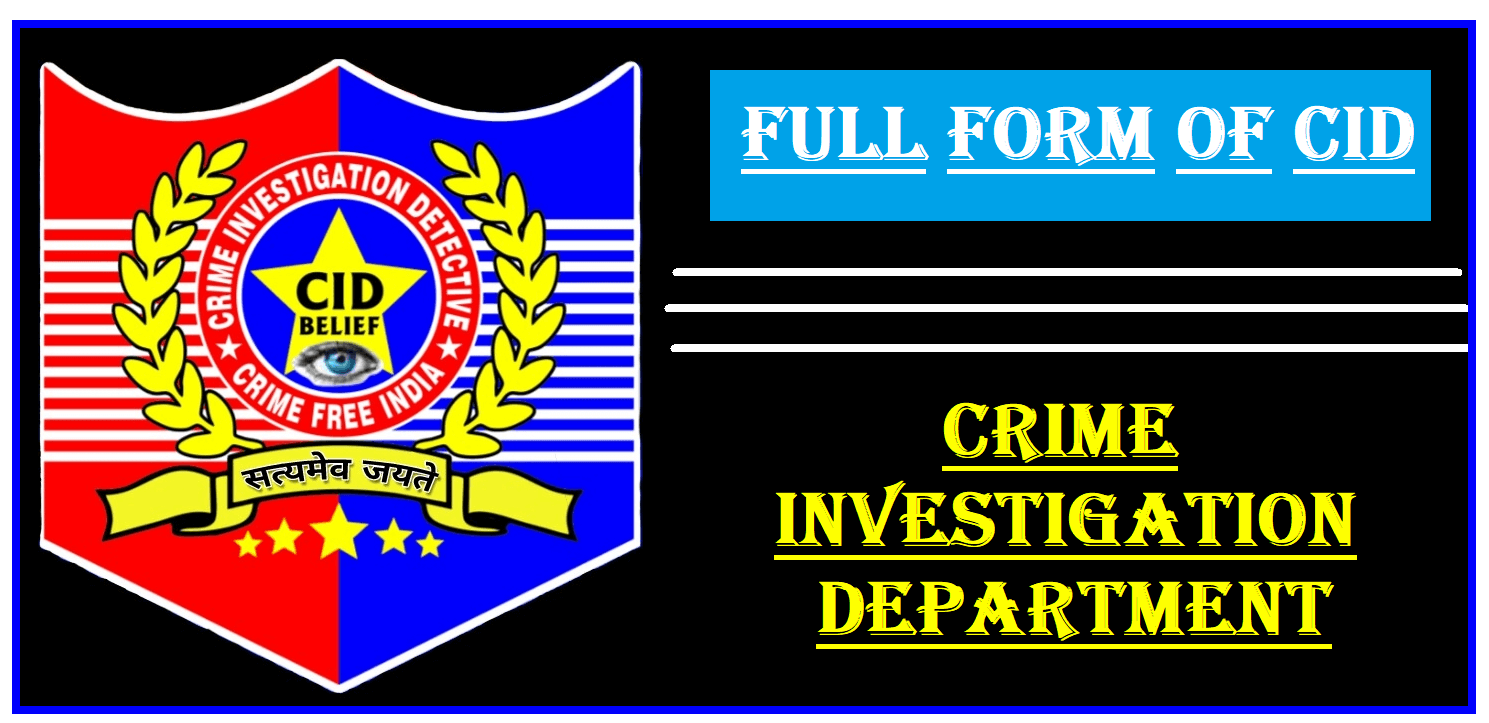Full Form of CID
Full Form of CID
C.I.D., the famous Television serial drama, is one of the popular shows cherished by Indian spectators for all age groups. The fascinating cases, the murder mysteries, and the impeccable case-solving attire are highly commendable. But do you know what does the abbreviation CID stands for?
The full form of the abbreviation CID is Crime Investigation Department.

Topics Covered:
- What is CID?
- History of CID
- Various CID Branches
- CID Ranks
- Types of Jobs Roles
- Eligibility criteria to become a CID officer
- Frequently Asked Questions/ FAQ’s
What is CID?
“CID or Crime Investigation Department is a State Police investigation and intelligence crime branch responsible for investigating murder cases, state riots, robbery, kidnapping, fraud, Serious Assault Case etc.”
CID is an investigation subdivision branch crime of the Indian State Police. It is one of the essential units of Indian Police organizations led by the PADG (Additional Police Director General). The headquarters of CID are located in Pune, Maharashtra in India. Unlike police officers, the CID officers (including various grades) do not have any specific uniform, and they investigate in regular clothes. Thus, they are also known as Detectives or CID.
CID is a leading investigation and intelligence department of the Indian State Police. Its primary function is to investigate criminal cases like sexual assault, murder, burglary, fraud, etc. They accumulate proof and evidence for crime sites, collect detailed summaries of the investigative process, interrogate the suspects, attend autopsies with forensic, conduct activities with different departments, catch the criminals and present the accused with evidence in Court. They leave no stone unturned in the investigation process and ensure that the case is closed fairly and equitably, giving justice to the victim. During the investigation of the case, the CID team can also demand the local police officers' help.
History of CID

CID is a legacy followed by the British Raj in India. Initially, CID was introduced in 1902 by the British Administration on the Police Commission's recommendations. Further, in 1929, the CID department was divided into two Special crime investigation Branches, i.e., CID and CB-CID. Since then, the special CID wing is led by the ADGP (Additional Director General of Police) and supervised by the IGP (Inspector-General of Police).
Various CID Branches
CID conducts its investigation and examination for crimes that include murder, fraud, robbery, sexual assault, riot, theft, etc. Hence, different branches are responsible for dealing with different levels of crimes. The various branches of CID are as follows:
- CID and Crime Branch
- Department of Human Rights
- Bank Frauds
- Missing Person cell and Anti-Human Trafficking
- Anti-Narcotics Cell
- Finger Print Bureau
- Anti-Terrorism Wing
- Dog Squad.
Various CID Ranks
The various ranks uphold by CID officers are as follows:
- Sub- Inspectors Post
- Inspectors Post
- Superintendents Post
- Inspector General of Police or IGP Post.
- Additional Director General of Police Post
Types of Jobs Roles

Unlike every other professional law enforcement agency, CID also holds different job profiles wherein the candidate can match his/her distinct interests areas and specializations. The CID job profiles that can be opted by the candidates are as follows:
- Fraud Investigator: A fraud investigator profile allows the officer to investigate only fraud cases by collecting evidence, facts, testimonies or confessions from complainants, employers and eyewitnesses. The officer is also responsible for researching records, acquiring, analyzing, and assess evidentiary information detection and analysis strategies.
- Police Officer: The Police officer's profile is to respond to incidents and complaints, prepare the documents, observe and prevent any danger to public safety, testify about cases and, unlike any other CID officer, gather all the possible evidence related to the case. They are also in charge of arresting the accused and sometimes the suspects.
- Investigative Officer: Investigative officers conduct interrogations with the witnesses and suspects to determine the guilty or the one who committed crimes. They collect all the related evidence to indict and convict suspects. They maintain written documentation of all the proofs and pieces of evidence and are frequently summoned in court to justify their investigations' conclusions.
- Criminologists: The job of a Criminologist is to conduct the investigation, analyze the theories, examine crime sites, and prepare the reports.
- Paralegal: A CID Paralegal officer's job is to investigate cases and laws of facts to discover the motive behind the crime of action and prepare the reports. Many times, they help lawyers or operate for law offices, legal government agencies or courts.
- Narcotics Officer: A Narcotics Officer's primary task is to prevent the drug's illicit smuggling in the state.
Eligibility criteria to become a CID officer
Every government job has its eligibility criteria, and so does CID. The basic requirements which are mandate to become a CID officer are given in the below table:
| Subject Combination | Any stream in class 12 |
| Entrance Exam | Indian Civil Services (ICS) examination organized by the UPSC (Union Public Service Commission) |
| Educational Qualifications | To apply for the CID entrance exam, a candidate must have a graduation degree (any stream) from a recognized college.A candidate who has accomplished his/her graduation can also apply for CID for the post of sub-inspector.There are several colleges in India that offer criminology and criminal justice programs at the graduation level, which could assist join CID. |
| Citizenship | The candidate must be an Indian citizen |
| Sex of the Candidate | MaleFemale |
| Minimum Age Required | 20 Years (for both male and female) |
| Upper Age Limit | 27 Years (for both male and female) |
| Age Relaxation | For SC/ST category candidates, a age relaxation of 5 years are permitted in the upper age limit i.e., 20 - 32 yearsFor SC/ST category candidates, a age relaxation of 5 years are permitted in the upper age limit i.e., 20 - 30 years |
| Minimum Height of the Candidate | Height required for Male is 165 cmHeight required for Female is 150 cmFor SC/ST, there is a relaxation of 5 cm for both male and female |
| Chest Expansion | 76 cm expansion |
| Eyesight Score | For Distant Vision the candidate must have 6/6 in any one of the eye and 6/9 vision score in the second eyeFor Near vision the candidate must have 0.6 vision score in one eye and 0.8 in the other eye |
| Number of Attempts | General Category have the rights to sit in the examination only for 4 attemptsOBC Category have the rights for 7 attemptsSC/ ST Category have no limits |
| Hiring Process | Written ExaminationPhysical Fitness ExamPersonal Interview Round |
| Extra Requirement | The candidate must have very good intellectual abilities, be 100% attentive, excellent judgment of criminal behavior and character, work under pressure, strong built, ability to work in a team as well as alone. |
Frequently Asked Questions/ FAQ’s
Question 1: What is CB-CID?
Answer: CB-CID is a sub-branch of CID led by the ADGP (Additional Director General of Police) department and supported by the IGP (Inspector-General of Police). This department is responsible for investigating the important and complicated criminal cases, including assassination, riot, fraud, duplication and various other spams consigned to CB-CID by the court, central government, or respective state governments.